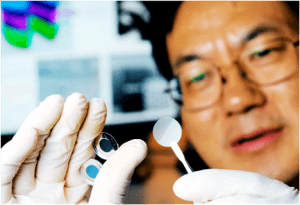A new type of power cell can convert mechanical energy—from walking, for example—to chemical energy and store the power until it is released as electrical current.
The power cell generates enough current to run a small calculator. A hybrid power cell the size of a conventional coin battery can power small electronic devices—and could have military applications for soldiers who might one day recharge battery-powered equipment as they walk.
“People are accustomed to considering electrical generation and storage as two separate operations done in two separate units,” says Zhong Lin Wang, a professor in the School of Materials Science and Engineering at the Georgia Institute of Technology. “We have put them together in a single hybrid unit to create a self-charging power cell, demonstrating a new technique for charge conversion and storage in one integrated unit.”
By eliminating the need to convert mechanical energy to electrical energy for charging a battery, the new hybrid generator-storage cell utilizes mechanical energy more efficiently than systems using separate generators and batteries.
At the heart of the self-charging power cell—described in the journal Nano Letters—is a piezoelectric membrane that drives lithium ions from one side of the cell to the other when the membrane is deformed by mechanical stress. The lithium ions driven through the polarized membrane by the piezoelectric potential are directly stored as chemical energy using an electrochemical process.
Using a mechanical compressive force with a frequency of 2.3 Hertz, the researchers increased the voltage in the power cell from 327 to 395 millivolts in just four minutes. The device was then discharged back to its original voltage with a current of one milliamp for about two minutes. The researchers estimated the stored electric capacity of the power cell to be approximately 0.036 milliamp-hours.
So far, Wang and his research team have built and tested more than 500 of the power cells. Wang estimates that the generator-storage cell will be as much as five times more efficient at converting mechanical energy to chemical energy for as a two-cell generator-storage system.
Much of the mechanical energy applied to the cells is now consumed in deforming the stainless steel case the researchers are using to house their power cell. Wang believes the power storage could be boosted by using an improved case.
“When we improve the packaging materials, we anticipate improving the overall efficiency,” he says. “The amount of energy actually going into the cell is relatively small at this stage because so much of it is consumed by the shell.”
Beyond the efficiencies that come from directly converting mechanical energy to chemical energy, the power cell could also reduce weight and space required by separate generators and batteries.
The mechanical energy could come from walking, the tires of a vehicle hitting the pavement, or by harnessing ocean waves or mechanical vibrations.
via Oilprice.com
The Latest Streaming News: Battery Breakthrough updated minute-by-minute
Bookmark this page and come back often
Latest NEWS
Latest VIDEO








